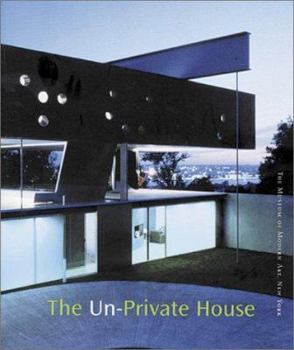The Un-Private House
How would you build a house for a cyborg? The Un-Private House examines this and other questions confronting domestic architecture at the dawn of a new millenium. Changes in family structure, shifting... This description may be from another edition of this product.
Format:Paperback
Language:English
ISBN:0870700979
ISBN13:9780870700972
Release Date:July 2002
Publisher:Museum of Modern Art
Length:152 Pages
Weight:1.40 lbs.
Dimensions:0.5" x 9.0" x 10.7"
Customer Reviews
2 ratings
The Avant Garde
Published by Thriftbooks.com User , 22 years ago
An amazing book of an equally amazing exhibition. The book continues where the exhibition left off, questioning what is private and what is not in each of the houses. More than that, the reader should look at each house and the "architectural letter" that it claims to write. Koolhaas' house is a Corbusian critique with a Miesian base. Xavier's house si definately Corbu, the slow house is a slug....and more. Each is an individual criticism on modern architecture and/or on the state of architecture today. A note:This is the most comprehensive list of architects that we should look out for....and are the worlds' best. Also if anyone can understand each of these projects, he has understood 80% of architecture today....(but that is if he "reads" each of the houses :-) Each house is prototypical of the architect's interests and what drives him.....see the house and you will understand all his other projects. BTW get that Menil house out of there. There is no letter he is writing.....
changing lifestyles influence home design
Published by Thriftbooks.com User , 24 years ago
Terrence Riley's introduction to the museum of modern art show's "The Unprivate House" sets up a great framework for categorizing the architectural intent of the 26 examples of residential design represented in this show. Riley reminds us that historically privacy was not always associated with dwellings. Just when we may have become committed to private dwellings, this book challenges that notion and asks us to consider the reality of our revolution in communication and media, complex multi-generational housing needs, and the fact that many homes actually house only a single person. This book provokes the question; what is the character of the housing that will best suit our changing times? Each of the examples challenges our thinking in some way concerning the design of residences today; e.g. should a mixed-use work/home space be clearly divided into distinct sections-even in distinct architectural materials or forms- or should these functions merge together, as is the case in the house designed for wall street currency traders (they even have a video monitor above their jacuzzi). Privacy is challenged to the greatest degree in the structure that closes itself off from the street with a literal "curtain wall." A perceived building line is virtually non- existent when the curtains are open.






